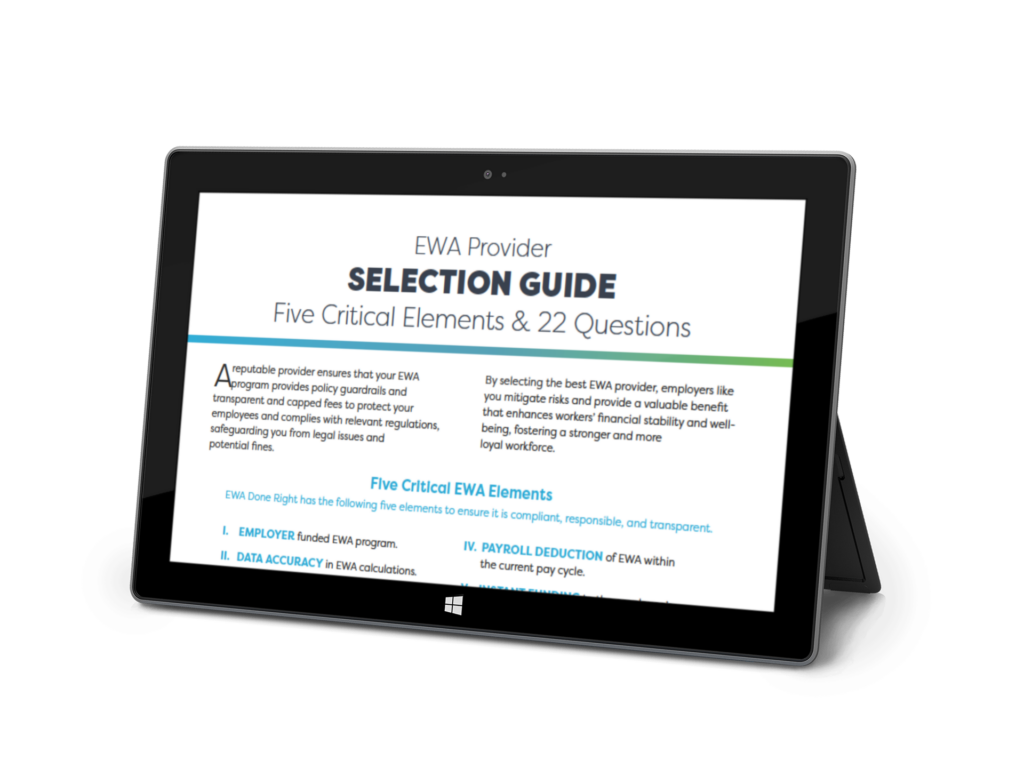A “Covered EWA Program” was defined by the Consumer Financial Protection Bureau (CFPB) in their advisory opinion, “Truth in Lending (Regulation Z); Earned Wage Access Programs.” A Covered EWA Program must meet seven critical criteria. As more and more state legislators look at enacting legislation around EWA, it is helpful to review the seven criteria and why they are vital in protecting consumers.
Estimated Reading Time: 6 minutes.

Earned Wage Access (EWA) and Consumer Protections
Regulatory compliance is paramount to ensuring consumer protection and fair practices in the ever-evolving financial services landscape. Earned Wage Access (EWA), also known as OnDemand Pay, has been undergoing significant regulatory scrutiny in the last several years. This voluntary benefit allows employees to access a portion of their earned wages before their regular payday.
With the emergence of EWA programs, the Consumer Financial Protection Bureau (CFPB) provided guidance to ensure that these services operate in a manner that protects consumers’ financial well-being.
This blog post delves into the CFPB’s Advisory Opinion on Earned Wage Access. It dissects the seven criteria every EWA vendor must meet to qualify as a covered program.
Understanding the CFPB’s Criteria For A Covered EWA Program
The CFPB’s Advisory Opinion outlines seven critical criteria that EWA programs must meet to qualify as covered programs under regulatory scrutiny. These criteria are designed to safeguard consumers’ interests and ensure fair and transparent practices within the industry.
Central to the CFPB’s advisory opinion is whether EWA programs are, in fact, loans. If considered a loan, an EWA program would fall under the jurisdiction of Regulation Z of the Truth In Lending Act (TILA), which protects consumers when dealing with loans and credit.
In their advisory opinion, the CFPB stated that if an EWA provider met the seven criteria, they would be considered a “Covered EWA Program” and would not be subject to Regulation Z of TILA.
(1) The Contract Is With The Employer
The first criterion focuses on who the contract for EWA services is with, the employer or the employee.
Two models have emerged to give employees access to their earned wages. The first is through an employer. This type of EWA is called employer-funded, employer-integrated, or business-to-business (B2B). When the contract is with the employer, integration is possible with HR and payroll systems, making it possible for the EWA vendor to calculate available wages accurately.
The second type is vendor-funded or direct-to-consumer (D2C)—in these models, the EWA vendor contracts directly with the employee/consumer. Information about the employee’s wages comes from the employee’s banking history, tracking an employee’s location via their phone, AI estimates, or data supplied directly from the employee. Accurate wage calculations can’t be verified because there is no connection to the employer’s payroll system.
EWA is a benefit that allows early access to wages.
When an EWA program is not connected to an employer’s payroll and HR systems, the employee’s wages cannot be verified. The EWA program has nothing to do with earned wage access; it must be a loan.
(2) Accrued Cash Value Of Wages
The next criterion focuses on accrued wages. First, the employer must provide data to calculate the employee wages. Second, the amount of the EWA transfer can be, at most, the accrued value of earned wages. The CFPB drew the analogy of the wages an employee would be entitled to if the employee separated from the job.
As explained above, without data from an employer, it is impossible to verify the wages earned.
Why does the CFPB focus on the “accrued value of earned wages?”
This goes back to a revision of Regulation Z and whether borrowing against an insurance policy or retirement plan is, in fact, a loan. The determination was that in such instances, the consumer is not borrowing but rather using their own money. In the same way, accurate accrued wages are the employee’s own money, not a loan.
However, the wages must be accurately calculated from employer data (no guessing or estimates).
(3) Employee Makes No Payment Beyond A Nominal Processing Fee
The third criterion addresses EWA program participation and transaction fees. To be a “Covered EWA Program,” the EWA vendor cannot charge fees to participate in the program*.
This third criterion makes monthly subscription EWA programs non-compliant.
The EWA vendor cannot charge to open an account or transfer funds to the employee’s choice of account.
This third criterion makes EWA programs that charge fees to transfer EWA funds to an employee’s debit card non-compliant.
* The CFPB noted that charging a “nominal processing fee” differs from a program participation fee.
EWA Provider Selection Guide
By selecting the best EWA provider, employers mitigate risks and provide a valuable benefit that enhances workers’ financial stability and well-being, fostering a more robust and loyal workforce. Use the 22 questions in the EWA Provider Selection Guide to evaluate and compare your current or prospective EWA Provider and ensure they offer a compliant, responsible, and transparent EWA solution.
Download the EWA Provider Selection Guide Now

(4) Recovery of Funds Through Payroll Deduction
The fourth criterion ensures transparency and clarity of the EWA transaction. When a payroll deduction recovers EWA funds, the transaction amount and fees are shown on the employee’s pay statement.
The employee’s gross earned wages, all taxes and deductions, and net pay are listed on the pay stub, making it easy for the employee to see the deduction.
Not recovering funds through payroll deduction means the EWA program is not covered, and the funds transfer is a loan.
The fourth Covered EWA Program criteria also specify how to handle technical or administrative issues (overpayments). The CFPB allows for one additional payroll deduction if a pay calculation error or a technical (API) error occurs.
Repeated attempts to recover funds disqualify the EWA program and turn the program back into a loan.
Some EWA programs allow an EWA vendor to control employee wages as part of the process. Employees who enroll in these EWA programs have their entire payroll direct deposit pay sent to the EWA provider. The EWA provider then deducts their transaction and fee amounts and proceeds to deposit the remaining pay into the employee’s account.
Trust and compliance issues arise when an unlicensed third party stands between an employer and the employee’s pay. If the recovery of EWA funds is not through a payroll deduction, then the program is a loan.
(5) No Remedy
The fifth criterion requires EWA programs not to attempt to recover monies from the employee.
Any EWA provider who tries to go after an employee for repayment is a loan provider, not an EWA provider.
(6) Acceptance of Terms and Conditions
The sixth criterion focuses on comprehensive disclosures, requiring EWA programs to provide clear and accurate information about the service’s terms and conditions, including any potential risks or limitations.
An EWA vendor who doesn’t clearly specify the terms and conditions of the EWA program violates the Covered EWA Program defined by the CFPB.
(7) No Credit Checks or Credit Risk Assessment
Lastly, the seventh criterion requires EWA programs to refrain from assessing an employee’s credit risk or conducting credit checks.
When an EWA vendor has access to an employee’s bank account data or entire employment history, they can use the data to assess the employee’s credit risk. Employers must understand how an EWA vendor is using the data to ensure compliance with the CFPB Covered EWA Program criteria.
Implications for EWA Providers
For EWA providers, compliance with the CFPB’s criteria is not only a regulatory requirement but also a strategic imperative. Failure to meet these criteria can result in regulatory scrutiny, reputational damage, and potential legal consequences. However, adherence to these criteria can also present opportunities for differentiation and competitive advantage in the market. EWA providers that prioritize consumer protection and transparency are likely to gain the trust and loyalty of consumers, leading to increased adoption and retention rates.
Consumer Protection and Compliance
Central to the CFPB’s criteria is the overarching goal of protecting consumers’ financial well-being. By ensuring that EWA programs operate fairly, transparently, and compliant with regulatory requirements, consumers can confidently access their earned wages without fear of exploitation or harm. Compliance with these criteria benefits consumers and strengthens the integrity and stability of the EWA industry as a whole.
Looking Ahead: Future Trends and Considerations
As the EWA industry evolves, EWA providers must remain vigilant and adaptable to emerging regulatory trends and considerations. Rapid technological advancements, changing consumer preferences, and evolving regulatory frameworks necessitate a proactive compliance and risk management approach. By staying abreast of industry developments and engaging with regulatory authorities and stakeholders, EWA providers can position themselves for long-term success in a dynamic and competitive market.
EWA Done Right
FlexWage delivers “EWA Done Right” because it offers the most compliant, responsible, and transparent Earned Wage Access (EWA) solution.
Schedule an introduction call today!
EWA Provider Selection Guide
By selecting the best EWA provider, employers mitigate risks and provide a valuable benefit that enhances workers’ financial stability and well-being, fostering a more robust and loyal workforce. Use the 22 questions in the EWA Provider Selection Guide to evaluate and compare your current or prospective EWA Provider and ensure they offer a compliant, responsible, and transparent EWA solution.
Download the EWA Provider Selection Guide Now

Keep exploring and learning >>>>> New State EWA Legislation—An Act Of Misplaced Trust and Faith?
